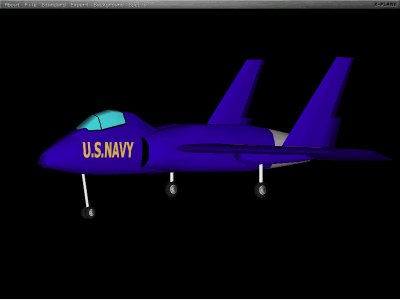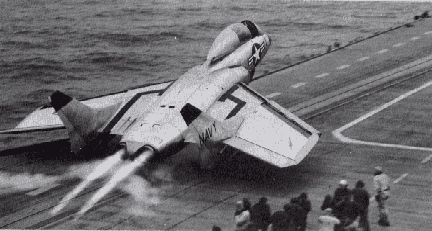

 |
 |
From fiddlersgreen.net
Among the large quantities of German aeronautical research data which began to reach the USA in the latter part of 1945 were details of some work on tailless designs done by the Arado company. Elaboration of these designs by the Chance Vought company led to production of the highly unconventional F7U Cutlass. The wing, with a sweepback of 38 degrees, was of very low aspect ratio, 3:1, and almost parallel chord. Pitch and roll controls were combined in elevons on the wing; fins and rudders were located on the wing at the ends of the centre section. Laid out as a carrier-based fighter, this design offered a high rate of climb and high top speed combined with comparatively small size when the outer wing panels were folded up for carrier stowage.
The US Navy ordered three XF7U-1 prototypes on June 25, 1946, specifying Westinghouse J34-WE-32 engines with afterburners. The first flight was made on September 29, 1948, by which time a production contract for 14 F7U-ls had been placed while development of the F7U-2 with J34-WE-42 engines and the F7U-3 with J46-WE-8As was initiated. The first F7U-l flew on March 1, 1950, and the entire batch of this model was assigned to the Advanced Training Command at Corpus Christi Naval Air Station during 1952. Difficulties with the Westinghouse J34 programme resulted in cancellation of the F7U-2 before completion, while early experience with the F7U-1 airframe led to an extensive redesign for the F7U-3. First flown on December 20, 1951, the latter model had a new nose shape, redesigned fins and other changes. Four squadrons were equipped-VF-81, VF-83, VF-122 and VF-124--and production of the definitive version totaled 162.
Basic armament of the F7U-3 comprised four 20 mm cannon in the upper lips of the intake fairing, with provision for underwing rocket pods or various other stores. Subsequently, provision was made for the Cutlass to carry four Sperry Sparrow I beam-riding missiles in the F7U-3M version, of which 100 were built, and 12 examples of a camera-equipped variant, the F7U-3P, also went into service. Production ended in December 1955 when 290 F7U-3 Cutlass variants had been delivered.
The real Cutlass has no flaps but does have leading edge slats. To enable the slats in X-Plane I had to add a small flaps section, so that's why you have a flap control on the panel.
The Cutlass is much easier to launch from a cat. Lower the flaps, go full throttle and then launch. Get the gear up as soon as you launch and then bring up the flaps as soon as you establish a positive rate of climb.
NEW - The version 1.1 of the Cutlass adds arrester gear (oops!) and changes to the engine specs to include the afterburner setting. Version 1.2 adjusts the center of gravity for a little better handling, tweaks the nacelles and paintjobs a bit, and makes a few other small changes.
Download the Vought F7U Cutlass version 1.2 (X-Plane version 5.62)


| Email James Z Temple | Return to Home Page |